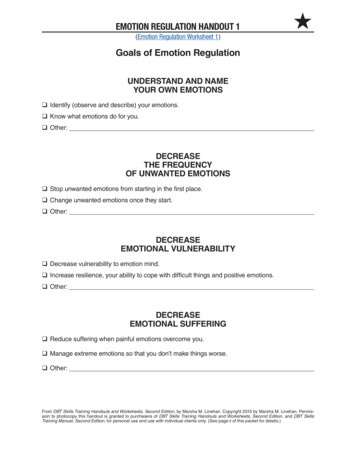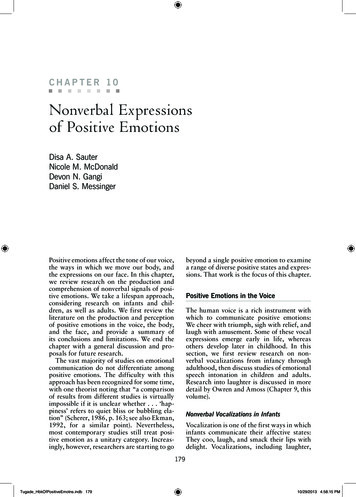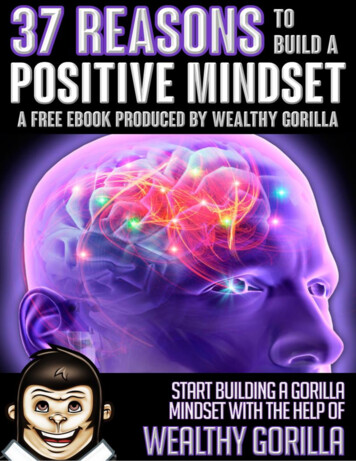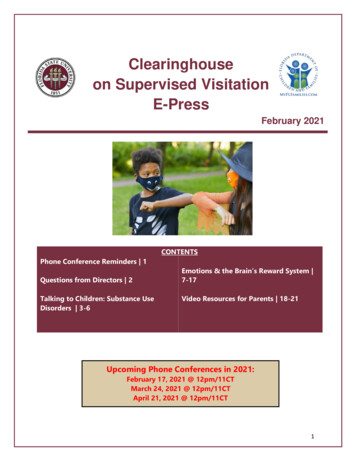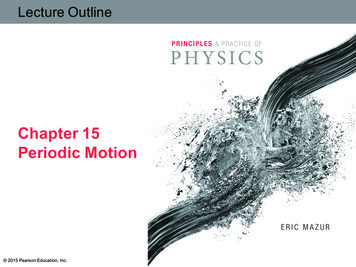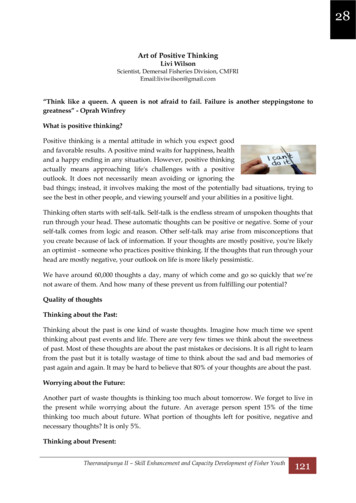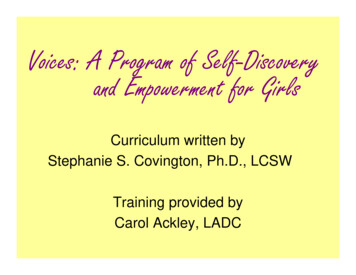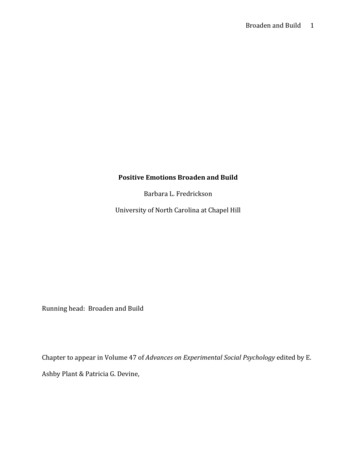
Transcription
Broaden and Build1Positive Emotions Broaden and BuildBarbara L. FredricksonUniversity of North Carolina at Chapel HillRunning head: Broaden and BuildChapter to appear in Volume 47 of Advances on Experimental Social Psychology edited by E.Ashby Plant & Patricia G. Devine,
AbstractBroaden and Build2This contribution offers a review, comprehensive to date, of a fifteen-year researchprogram on the broaden-and-build theory of positive emotions. Although centered onevidence that has emerged from Fredrickson’s Positive Emotions and PsychophysiologyLaboratory (PEP Lab), it features key findings from other laboratories as well. It beginswith a description of ten representative positive emotions, alongside approaches forassessing them, both directly with the modified Differential Emotions Scale and indirectlythrough physiological and implicit measures. Next, it offers the seeds of the broaden-andbuild theory, including work on the undo effect of positive emotions. It then reviews thestate of the evidence for the twin hypotheses that stem from the broaden-and-build theory,the broaden hypothesis and the build hypothesis, including a focus on upward spiraldynamics. It touches next on new frontiers for the theory, including deeper investigationsinto the biological resources that positive emotions build as well as clinical andorganizational applications. Finally, this contribution closes with a brief presentation oftwo offshoots from the broaden-and-build theory, namely, the upward spiral model oflifestyle change, and work on love as positivity resonance between and among people. Bothare targets of increasing work in the PEP Lab.
Broaden and Build3Positive Emotions Broaden and BuildFrom its very start, psychology has harbored an inferiority complex. Despite the factthat behavioral scientists rely on the scientific method and strivings for valid and reliablemeasures just as fervently as do those working in the natural sciences, this complexpersists. Psychology has too often played the social comparison game, looking up to thenatural sciences and medicine, pressing its nose against the glass ceiling of these highprestige enterprises, while trying to climb away from and distinguish itself from thehumanities and other social sciences, claiming greater empirical validity and relevancy. Therecent trend to rename academic departments of “Psychology” as departments of“Psychological Science” or “Psychology and Brain Science” may well reflect this insecurity(Kihlstrom, 2012).One outward legacy of this deep-seated inferiority complex has been to stay clear oftopics that fall under the umbrella of human behavior and experience that are deemed toosoft, frivolous, or ethereal. However intriguing they may be, experiences marked by levityor delight were long ignored by psychologists, perhaps for fear that they might somehowspoil an outward impression of rigor or objectivity. For psychology to be taken seriously asa science, it seemed, required not only that it be rigorous and objective – by following theprinciples of the scientific method – but that is also appear rigorous and objective bytackling problems of grave nature, like mental illness, violence, or social ostracism.It is true that emotion, a concept often cast as ethereal, was an early topic withinpsychology (e.g., James, 1884; Cannon, 1929). Yet emotional phenomena were eventuallycordoned off in the zeitgeist of behaviorism, whose proponents cataloged them as
Broaden and Buildirrelevant and misleading epiphenomena (Skinner, 1974), and derided those who studied4them as mentalists. Although a few unorthodox psychologists ventured off the beaten pathto study emotions nevertheless (e.g., Silvan Tompkins, 1962, whose work inspired PaulEkman, Carroll Izard, among others), emotions science did not emerge as an organizedsubspecialty until the mid 1980s, as marked by the formation of the International Societyfor Research on Emotions (ISRE) in 1984, the first multi-disciplinary professionalassociation for scholars specializing in this area. It’s fair to say that in the thirty years since,research on emotions has exploded.Yet even decades after emotions became a rigorous and accepted topic of scientificinquiry, psychology’s inferiority complex held sway to keep the focus on the most seriousof emotions, namely fear, anger, sadness, and the like. Even disgust made its way to thefore (e.g., Rozin & Fallon, 1987). It was as if the light-hearted emotions within the humanrepertoire might somehow weaken the fibers of the cloak of rigor that has been soimportant for psychology to don. This is my sense of how psychology could exist as ascience for an entire century before psychologists were allowed to take a close empiricallook at positive emotions without jeopardizing their reputations.I have had the good fortune to work on the leading edge of the new and amplyrigorous science of positive emotions. Together with the students and collaborators whohave worked with me in my Positive Emotions and Psychophysiology Laboratory (PEP Lab,first at the University of Michigan and now at the University of North Carolina at ChapelHill), I have sought to create an evidence-based understanding of light-hearted moments,charting their variety, the ways they change how the human mind works, and how, littleby-little, they change people’s lives. This was not an easy program of research to launch.
Broaden and BuildMy first empirical work on positive emotions was in fact rejected countless times over the5span of seven years before it saw publication (i.e., Fredrickson & Levenson, 1998). Whileserial rejections are never pleasant, this early resistance taught me important lessons bothabout scholarly precision and about resilience and persistence. The purpose of this chapteris to review the now longstanding PEP Lab research program on positive emotions,centered on my broaden-and-build theory, with discussion of relevant studies from otherlaboratories as well. I begin with a description of the various affective phenomena mycollaborators and I target.Ten Representative Positive EmotionsI set the stage for this review by briefly describing ten key positive emotions. This isby no means an exhaustive list. I choose to focus on these ten emotions not only becausethey are the targets of increasing research, but also because evidence from the PEP Labsuggests that these ten are experienced relatively frequently in people’s daily life. With oneimportant exception, I describe them in the order of their relative frequency, starting withthe positive emotions people appear to feel most often, and moving on to those that theyfeel more rarely. The exception is love, which in our studies emerges as the mostfrequently experienced positive emotion. As described below, I see good reason todescribe it last.Like all emotions, positive emotions are brief, multi-system responses to somechange in the way people interpret – or appraise – their current circumstances. When thismulti-system response registers that circumstances are somehow bad for the self, anegative emotion arises, when it registers good prospects or good fortune, a positiveemotion arises. To foreshadow the broaden-and-build theory, for each of these ten positive
Broaden and Buildemotions, I describe (a) the appraisal patterns that trigger it, (b) the broadened thoughtaction repertoire it sparks, and (c) the durable resources that it helps to build. Table 1offers these in summary form across its first four columns.Joy. Joy emerges when one’s current circumstances present unexpected goodfortune. People feel joy, for instance, when receiving good news or a pleasant surprise. Joycreates the urge to play and get involved, or what Frijda (1986) termed free activation,defined as an “aimless, unasked-for readiness to engage in whatever interaction presentsitself” (p. 89). The durable resources created through play are the skills acquired throughthe experiential learning it prompts.Gratitude. Gratitude emerges when people acknowledge another person as thesource of their unexpected good fortune. Joy becomes gratitude, for instance, whenawareness of one’s own good fortune is combined with admiration for another person forthoughtfully going out of their way to create that good fortune (Algoe, in press). Gratitudecreates the urge to creatively consider new ways be kind and generous oneself. Thedurable resources accrued when people act on this urge are new skills for expressingkindness and care to others.Serenity. Also called contentment, serenity emerges when people interpret theircurrent circumstances as utterly cherished, right, or satisfying. People feel serenity, forinstance, when they feel comfortable, at ease in, or at one with their situation. Serenitycreates the urge to savor those current circumstances, and integrate them into newpriorities or values. The durable resources created through savoring and integratinginclude a more refined and complex sense of oneself and of one’s priorities.6
Broaden and BuildInterest. Interest arises in circumstances appraised as safe but offering novelty.7People feel interest, for instance, when they encounter something that is mysterious orchallenging, yet not overwhelming. Interest creates the urge to explore, to learn, toimmerse oneself in the novelty and thereby expand the self (Izard, 1977; Silvia, 2008). Theknowledge so gained becomes a durable resource.Hope. Whereas most positive emotions arise in circumstances appraised as safe,hope is the exception. Hope arises in dire circumstances in which people fear the worst, yetyearn for better (Lazarus, 1991). People feel hope, for instance, in grim situations in whichthey can envision at least a chance that things might change for the better. Hope creates theurge to draw on one’s own capabilities and inventiveness to turn things around. Thedurable resources it builds include optimism and resilience to adversity.Pride. Pride emerges when people take appropriate credit from some socially-valued good outcome. People feel pride, for instance, when they accomplish an importantgoal (Tracy & Robins, 2007). Pride creates the urge to fantasize about even biggeraccomplishments in similar arenas. The big dreams sparked by pride contribute to thedurable resource of achievement motivation (Williams & DeSteno, 2008).Amusement. Amusement occurs when people appraise their currentcircumstances as involving some sort on non-serious social incongruity. It can erupt, forinstance, in the wake of a harmless speech error or physical blunder. Amusement createsurges to share a laugh and find creative ways to continue the joviality. As people followthese urges, they build and solidify enduring social bonds (Gervais & Wilson, 2005).Inspiration. Inspiration arises when people witness human excellence in somemanner. People feel inspired, for instance, when they see someone else do a good deed, or
Broaden and Buildperform at an unparalleled level. Inspiration creates the urge to excel oneself, to reach8one’s own higher ground or personal best. The durable resource it builds is the motivationfor personal growth (Algoe & Haidt, 2009; Thrash & Elliot, 2004).Awe. Awe emerges when people encounter goodness on a grand scale. People feelawe, for instance, when overwhelmed by something (or someone) beautiful or powerfulthat seems larger than life. The experience of awe compels people to absorb andaccommodate this new vastness they’ve encountered. The durable resources awe createsare new worldviews (Shiota, Keltner, & Mossman, 2007).Love. Love, which appears to be the positive emotions people feel most frequently,arises when any other of the positive emotions is felt in the context of a safe, interpersonalconnection or relationship. I will offer a richer description of love later in this chapter,when I discuss positivity resonance as an offshoot of the broaden-and-build theory. Fornow, suffice it to say that as an amalgam of other positive emotions, love broadens thoughtaction repertoires both in an “all of the above” manner, and by creating momentaryperceptions of social connection and self-expansion. Likewise, love builds a wide range ofenduring resources, especially social bonds and community.Assessment ApproachesMy empirical approach has been to assess each of these positive emotions viapeople’s self-reports of their own subjective experiences, whether in response to (a) anemotion induction presented in the laboratory, (b) a repeated end-of-day survey of theirexperiences over the past 24 hours, or (c) a questionnaire inquiring about their emotionalexperiences over the past two weeks. To do this, the PEP Lab uses a variant of the modifiedDifferential Emotions Scale (mDES, see Appendix; Fredrickson, Tugade, Waugh, & Larkin,
Broaden and Build2003) selected to fit the temporal frame of a given study design. The mDES i expanded on9the Differential Emotions Scale (DES; Izard, 1977) to include a far wider set of positiveemotions. I created the mDES to be a more encompassing measure of positive emotionsthan the more commonly used PANAS, which exclusively targets high activation positiveaffective states (Watson, Wiese, Vaidya, & Tellegen, 1999). Like the DES before it, the mDESuses a trio of emotion adjectives to capture each emotion. The fifth column in Table 1presents the particular trio used in the mDES for each of the ten positive emotions in turn.Based on evidence that people are better at recalling peak emotional experiences than theyare at aggregating across multiple affective episodes (Fredrickson & Kahneman, 1993;Kahneman, Fredrickson, Schreiber, & Redelmeier, 1993), we typically ask respondents toindicate “the greatest amount that you’ve experienced each of the following feelings”(response options: 0 not at all; 1 a little bit; 2 moderately, 3 quite a bit; and 4 extremely). At times, however, we inquire about the frequency of experience, by askingrespondents “How often did you feel ?” (response options: 0 never; 1 rarely; 2 some of the time; 3 often; 4 most of the time). Depending on our empirical approach, weask respondents to think back to a particular laboratory procedure (e.g., a given film oractivity), the past 24 hours, or the past two weeks. In all cases, each of 20 distinct emotionsis represented by a trio of affective adjectives. Those for the positive emotions are suppliedin Table 1 (researchers interested in using the mDES may download various versions fromthe PEP Lab website, www.PositiveEmotions.org). While at times my collaborators and Iexamine individual items of the mDES to explore the effects of specific emotions orlaboratory inductions, most often we aggregate the 10 positive and 10 negative emotionitems separately to create independent positive and negative emotion scores, respectively.
Broaden and BuildThese scales yield high internal reliability, ranging from .82 to .94 (Cohn, Fredrickson,10Brown, Mikels, & Conway, 2009; Fredrickson, Cohn, Coffey, Pek, & Finkel, 2008).Beyond the explicit self-reports of emotion experience captured by the mDES, in ourlaboratory-based studies my PEP Lab regularly uses facial electromyography (EMG) tocapture the frequency of Duchenne smiles, using a new data-reduction techniquedeveloped by former students Kareem Johnson and Christian Waugh (Johnson, Waugh, &Fredrickson, 2010). To further circumvent demand effects, we’ve also used a range ofimplicit measures of positive affect (e.g., lexical decision task, LDT, Niedenthal, Halberstadt,& Setterlund, 1997; affect misattribution procedure, AMP, Payne, Cheng, Govorun, &Stewart, 2005). We also deploy a version of Russell’s Affect Grid (Russell, Weiss, &Mendelsohn, 1989) especially when in need of densely-repeated measures of emotionwithin a single laboratory visit. We modify the Affect Grid by revising the emotionadjectives that appear around the grid’s perimeter to best fit our current empiricalobjectives. I direct readers interested in a deeper discussion of emotion measurement to achapter Randy Larsen and I wrote on this topic for an edited volume on well-being (Larsen& Fredrickson, 1999).Seeds of the Broaden-and-Build TheoryThe Undo Effect of Positive EmotionsI began my formal study of emotions as a post-doctoral fellow in the early 1990s,supported by the NIMH training grant on emotions led by Paul Ekman and Richard Lazarus.My intellectual curiosity about positive emotions was piqued by the simple fact that theywere so rarely discussed in the existing empirical literature. Working with RobertLevenson at UC Berkeley, I became captivated by the two sentences Levenson had devoted
Broaden and Buildto positive emotions in a chapter he’d written on best practices for investigating whether11specific discrete emotions carried unique autonomic signatures. In discussing the crucialissue of how to select an appropriate baseline against which to examine the physiologicaleffects of distinct emotions, he wrote “ the evolutionary meaning of positive emotionssuch as happiness might be to function as efficient ‘undoers’ of states of ANS [autonomicnervous system] arousal produced by certain negative emotions. To test this hypothesis areasonable baseline condition for the investigation of ANS concomitants of happinesswould be one that produces a prior state of fear, anger or sadness.” (Levenson, 1988, p. 25).Indeed, prior work by Levenson and colleagues had examined the autonomic effects of“happiness” assessed against the more commonly used baseline of neutral affect(Levenson, Carstensen, Friesen, & Ekman, 1991; Levenson, Ekman, & Friesen, 1990).Results of this earlier work showed essentially no autonomic signature whatsoever for thispositive emotion, which seemed a puzzle.So at the start of my post-doctoral fellowship, in the fall of 1990, Levenson and Idesigned an initial laboratory experiment to test this undo hypothesis (Fredrickson &Levenson, 1998). As Levenson had proposed, we examined the effects of positive emotionsagainst the backdrop of a negative emotion, in this case fear. We did, of course, also includea prior neutral baseline to establish the effects of our fear induction. We used a short videoclip that capitalized on a fear of heights, to create a common negative emotion in allparticipants, who were female students at the University of Berkeley. The clip showed aman inching along the outer ledge of a high-rise, hugging the side of the building; at onepoint he loses his footing, grasps at whatever he can and dangles high above traffic,struggling to keep from dropping to his certain death.
Broaden and Build12From pretesting we knew that this short clip, just 83 seconds long, was effective ininducing fear specifically. Participants in this experiment reported their own subjectiveexperiences of emotion by manipulating a rating dial whose pointer moved on a continuous180-degree scale, labeled from “very negative” (0) to “neutral” ( 4.5) to “very positive” (9).During their pre-video resting baseline period, mean rating dial reports were near 5 (veryslightly positive), whereas during this high-rise ledge clip participants’ ratings dropped toabout 3 (negative). More importantly for testing the undo hypothesis, participants alsoexperienced significant cardiovascular reactivity to this video clip, with 3 of 4cardiovascular measures showing significant change relative to resting baseline, namely,heart rate; finger pulse amplitude, an index of peripheral vasoconstriction; and pulsetransmission time to the ear, a correlate of blood pressure. Pulse transmission time to thefinger was also measured, but did not show significant change during the fear clip and sowas not used within our aggregate index of cardiovascular recovery in this initial study.We tested the undo hypothesis by randomly assigning participants to view one offour different short video clips immediately following the fear-inducing ledge clip. Frompretesting, we knew that two of the four clips evoked two different positive emotions,amusement and contentment. These clips presented images of a puppy playing and oceanwaves, respectively. A third was known to be neutral, eliciting no emotion whatsoever bypresenting a 1990s-era computer screensaver, and a fourth was known to elicit sadness byshowing a boy crying at the death of his father. Importantly, the two positive and theneutral clips, when viewed following a standard resting baseline, produce virtually nocardiovascular signatures whatsoever (Fredrickson, Mancuso, Branigan, & Tugade, 2000,Study 2). That is, there’s no way that anyone could know, just by looking at the ensuing
Broaden and Buildphysiological responses, whether someone were watching puppies, waves, or a simple13screensaver. We chose sadness as an additional comparison condition because although itproduces small increases in sympathetic activation (Fredrickson et al., 2000), unlike othernegative emotions, it is not associated with any high-action motor program (Fredrickson &Levenson, 1998), like fight or flight that co-opts the sympathetic nervous system. Mostoften it is associated with inactivity or disengagement and as such, one might expect it, too,to speed cardiovascular recovery.So although positive emotions do not appear to “do” anything to the cardiovascularsystem, when viewed against the backdrop of pronounced negative emotional arousal, thepositive emotions clearly stood out in their ability to “undo” lingering cardiovascularactivation. Compared to either those in the neutral condition, who took about 40 secondsto recover, or those in the sad conditions, who took about 60 seconds to recover, those inthe amusement and contentment conditions showed the fastest cardiovascular recovery,recovering within about 20 seconds each (Fredrickson & Levenson, 1998, Study 1).Across two subsequent experiments, conducted in my own newly-establishedlaboratory at the University of Michigan, my students and I replicated this exact pattern ofresults using samples more diverse in age, gender, and ethnicity. We also used a moreactive and self-relevant way to induce the initial negative emotion by having participantsprepare to deliver a speech on “Why you are a good friend” under considerable timepressure, which, they were told, would be videotaped for later evaluation by students inanother study. We also instructed participants that there was a 50-50 chance that “thecomputer” would select them to give their speech or not. If “by chance” they were notselected to give their speech, a video clip would begin on the monitor that was placed
Broaden and Buildbefore them. In actuality no participants were asked to deliver their prepared speeches.14This cover story was developed both to boost the anxiety of the speech preparation taskand to justify the quick switch to an unrelated video clip. While our later experiments usedthe same clips to elicit amusement, contentment, neutrality, and sadness as the originalFredrickson-Levenson experiment, we expanded the array of cardiovascular measures wetracked to include beat-by-beat assessments of both systolic and diastolic blood pressure.The speech task produced clear and pronounced experiences of anxiety, as indicatedboth by participants’ self-reports of their subjective experience, and by significant changesacross the entire set of 6 cardiovascular measures we tracked, each in the direction ofheightened sympathetic arousal (Fredrickson, et al., 2000, Study 1, Samples 1 and 2).Notably, using different samples, different cardiovascular measures, and a different initialnegative emotion from which to recover, two distinct positive emotions again yieldedsignificantly faster recovery from the cardiovascular sequelae of negative emotions.Using archival data that I’d collected in Levenson’s lab at UC Berkeley, I also testedthe undo hypothesis using a more spontaneous and ecologically valid pairing of negativeand positive emotions. People vary in their responses to negative experiences. Forwhatever reasons, some people smile in the face of sadness and adversity whereas othersdo not. We explored whether those who smiled during a notably sad film clip (the funeralscene from Steel Magnolias, clipped prior to the humorous interchanges), would showfaster cardiovascular recovery after the clip ended. Those who smiled at least once duringthe sad clip, the data suggested, recovered about 20 seconds faster than those who neversmiled (Fredrickson & Levenson, 1998, Study 2).
Broaden and Build15Whereas Levenson had supplied the original hypothesis that launched our researchon the undo effect of positive emotions, my contribution was to develop a time-basedmeasure of cardiovascular recovery with fine-grained temporal resolution. As wasstandard in Levenson’s lab, we had extracted second-by-second data on participants’responses during the resting baseline as well as during the film sequences they saw. Usingthese data, I calculated a confidence interval around each participant’s baseline level ofactivation defined by their mean activation over the last 60-seconds of a 2-minute restingbaseline period, plus and minus one standard deviation of that mean. This confidenceinterval was used to characterize each participants’ own state of emotional quiescence.During the fear clip, all participants’ responses moved out of this relaxed state, as would beexpected with the experience of fear. Then, at the start of the randomly-assigned secondaryvideo clips, I calculated the time, in seconds, for each participants’ cardiovascularresponses to return to within the confidence interval that represented their own relaxedstate and remain within this interval for 5 of 6 consecutive seconds. I did this for eachcardiovascular measure that had shown reactivity in response to the initial negativeemotion and then aggregated the recovery times across distinct cardiovascular measures.This data reduction approach was, at the time, novel. Most investigators assessed recoveryindirectly, by re-assessing the magnitude of a cardiovascular response some minutes laterand then inferring recovery from any evident reductions in reactivity. Our more sensitivetime-based measure of cardiovascular recovery preceded the later and eventually moresophisticated appreciation for affective chronometry, the investigation of the temporalcourse of emotion experiences (e.g., Davidson, 1998; Waugh, Hamilton, & Gotlib, 2010).
Broaden and Build16An offshoot of this early work on the undo effect of positive emotions emerged as anauxiliary branch of research on resilience. Using Block and Kremen’s 14-item self-reportmeasure of Ego-Resilience (ER89; Block & Kremen, 1996), we discovered that people whoscore higher on this index of trait resilience appear to spontaneously harness the undoeffect of positive emotions to regulate their own negative emotional experiences. Forinstance, when faced with the same anxiety-producing speech preparation task, peoplewho score higher on resilience showed significantly faster cardiovascular recovery.Moreover, their quicker recovery was mediated by their greater tendency to experiencepositive emotions in response to the task, intermixed with their anxiety (Tugade &Fredrickson, 2004, Study 1).In a second study, by random assignment we had some participant reframe thespeech preparation task as an interesting challenge to overcome versus a threat. Under thetypical threat instructions, we replicated the effect wherein people who score higher onBlock and Kremen’s resilience measure showed faster cardiovascular recovery. Bycontrast, under challenge instruction, we found that people who scored lower on resilienceshow the same swift cardiovascular recovery as their high resilient counterparts.Moreover, their speedy recovery was mediated by the greater positive emotions theyexperienced in response to the task alongside their anxiety. Data from both studies bolsterthe undo effect of positive emotions by suggesting that positive emotions serve as usefulresources for regulating negative emotional experiences in daily life. Beyond promotingcardiovascular quiescence, positive emotions have also been found to (a) help resilientpeople find positive meaning in difficult life circumstances (Tugade & Fredrickson, 2004,Study 3), (b) buffer against depressive symptoms and fuel post-crisis growth in the wake of
Broaden and Build17the September 11th, 2001 terrorist attacks (Fredrickson, et al., 2003), and (b) help peopleeffectively recover from stress both in daily life and during bereavement (Ong, Bergeman,Bisconti, & Wallace, 2006).The Birth of the Broaden-and-Build TheoryThe transition in my own thinking from the undo effect to the broaden-and-buildtheory of positive emotions carries an interesting lesson about the importance of having anappropriate balance of positive to negative emotions for generative thinking. As my firstwork targeting positive emotions, my studies on the undo effect ignited my fascination withthe evolutionary origins of these light-hearted states. Within the still new renaissance ofemotions science, very little work targeted emotions with a pleasant subjective feel. Thismade positive emotions largely uncharted terrain, which presented my favorite kind ofintellectual landscape. Although it’s not always wise to toil in areas unplowed by others, itcertainly provides vast areas to freely explore and ponder.In our first musings about how existing emotion theory was perhaps unsuitable forthe positive emotions, Levenson and I pointed out that the lynchpin theory that specificemotions activate specific action tendencies did not neatly extend to the positive emotions(Fredrickson & Levenson, 1998). The concept of specific action tendencies had become socentral within emotions science because it simultaneously explained not only whyemotions evoke bodily changes (to support specific action urges) but also why emotionsexist (because these specific actions helped human ancestors survive specific and recurringthreats to life a
the broaden hypothesis and the build hypothesis, including a focus on upward spiral dynamics. It touches next on new frontiers for the theory, including deeper investigations into the biological resources that positive emotions build as well as clinical and organizational applications. Finally, this contribution closes with a brief presentation of
